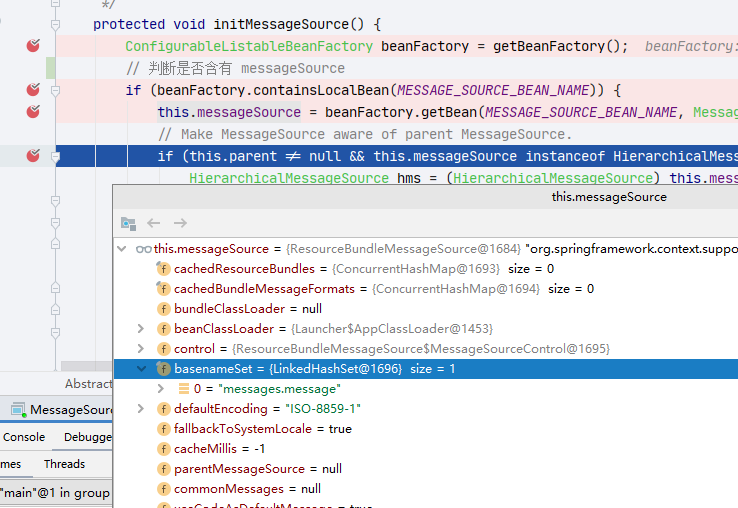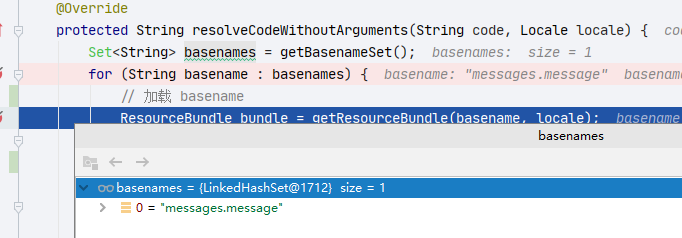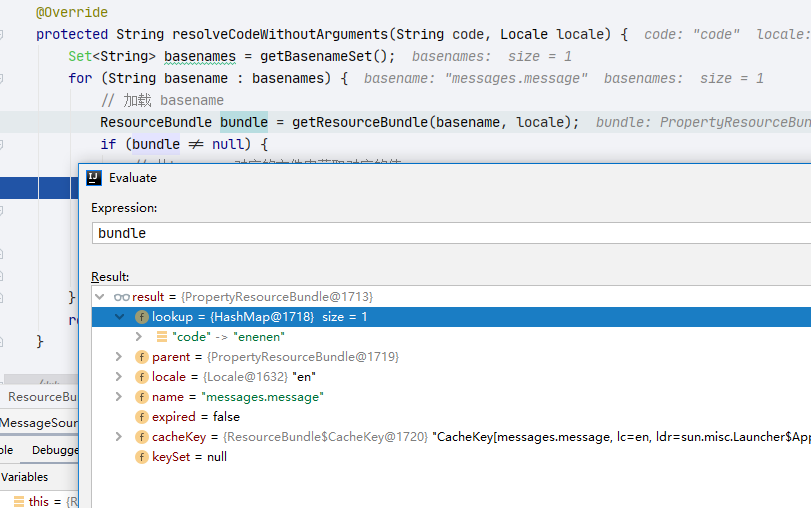Spring MessageSource
- Author: HuiFer
- 源码阅读仓库: SourceHot-Spring
初始化入口
org.springframework.context.support.AbstractApplicationContext.refresh方法有initMessageSource()方法进行了MessageSource初始化
protected void initMessageSource() {ConfigurableListableBeanFactory beanFactory = getBeanFactory();// 判断是否含有 messageSourceif (beanFactory.containsLocalBean(MESSAGE_SOURCE_BEAN_NAME)) {// 读取xml配置文件中 id="messageSource"的数据this.messageSource = beanFactory.getBean(MESSAGE_SOURCE_BEAN_NAME, MessageSource.class);// Make MessageSource aware of parent MessageSource.if (this.parent != null && this.messageSource instanceof HierarchicalMessageSource) {HierarchicalMessageSource hms = (HierarchicalMessageSource) this.messageSource;if (hms.getParentMessageSource() == null) {// Only set parent context as parent MessageSource if no parent MessageSource// registered already.hms.setParentMessageSource(getInternalParentMessageSource());}}if (logger.isTraceEnabled()) {logger.trace("Using MessageSource [" + this.messageSource + "]");}}else {// Use empty MessageSource to be able to accept getMessage calls.// 没有使用默认的 DelegatingMessageSourceDelegatingMessageSource dms = new DelegatingMessageSource();dms.setParentMessageSource(getInternalParentMessageSource());this.messageSource = dms;// 注册单例对象beanFactory.registerSingleton(MESSAGE_SOURCE_BEAN_NAME, this.messageSource);if (logger.isTraceEnabled()) {logger.trace("No '" + MESSAGE_SOURCE_BEAN_NAME + "' bean, using [" + this.messageSource + "]");}}}
读取 xml 配置文件

getMessage
org.springframework.context.support.AbstractApplicationContext#getMessage(java.lang.String, java.lang.Object[], java.util.Locale)
@Overridepublic String getMessage(String code, @Nullable Object[] args, Locale locale) throws NoSuchMessageException {return getMessageSource().getMessage(code, args, locale);}
org.springframework.context.support.AbstractMessageSource#getMessage(java.lang.String, java.lang.Object[], java.util.Locale)@Overridepublic final String getMessage(String code, @Nullable Object[] args, Locale locale) throws NoSuchMessageException {// 获取对应的信息String msg = getMessageInternal(code, args, locale);if (msg != null) {return msg;}// 默认信息 nullString fallback = getDefaultMessage(code);if (fallback != null) {return fallback;}throw new NoSuchMessageException(code, locale);}
两个方法
org.springframework.context.support.AbstractMessageSource#getDefaultMessage(java.lang.String)@Nullableprotected String getDefaultMessage(String code) {// 判断是否使用默认值if (isUseCodeAsDefaultMessage()) {return code;}return null;}
- 返回 code 本身或者
null
org.springframework.context.support.AbstractMessageSource#getMessageInternal@Nullableprotected String getMessageInternal(@Nullable String code, @Nullable Object[] args, @Nullable Locale locale) {if (code == null) {return null;}if (locale == null) {// 获取语言默认值locale = Locale.getDefault();}Object[] argsToUse = args;if (!isAlwaysUseMessageFormat() && ObjectUtils.isEmpty(args)) {// Optimized resolution: no arguments to apply,// therefore no MessageFormat needs to be involved.// Note that the default implementation still uses MessageFormat;// this can be overridden in specific subclasses.String message = resolveCodeWithoutArguments(code, locale);if (message != null) {return message;}}else {// Resolve arguments eagerly, for the case where the message// is defined in a parent MessageSource but resolvable arguments// are defined in the child MessageSource.argsToUse = resolveArguments(args, locale);MessageFormat messageFormat = resolveCode(code, locale);if (messageFormat != null) {synchronized (messageFormat) {return messageFormat.format(argsToUse);}}}// Check locale-independent common messages for the given message code.Properties commonMessages = getCommonMessages();if (commonMessages != null) {String commonMessage = commonMessages.getProperty(code);if (commonMessage != null) {return formatMessage(commonMessage, args, locale);}}// Not found -> check parent, if any.return getMessageFromParent(code, argsToUse, locale);}
org.springframework.context.support.ResourceBundleMessageSource#resolveCodeWithoutArguments@Overrideprotected String resolveCodeWithoutArguments(String code, Locale locale) {Set<String> basenames = getBasenameSet();for (String basename : basenames) {// 加载 basenameResourceBundle bundle = getResourceBundle(basename, locale);if (bundle != null) {// 从basename对应的文件中获取对应的值String result = getStringOrNull(bundle, code);if (result != null) {return result;}}}return null;}

加载后截图
获取方法
String result = getStringOrNull(bundle, code);就是 map 获取

没有配置文件的情况


